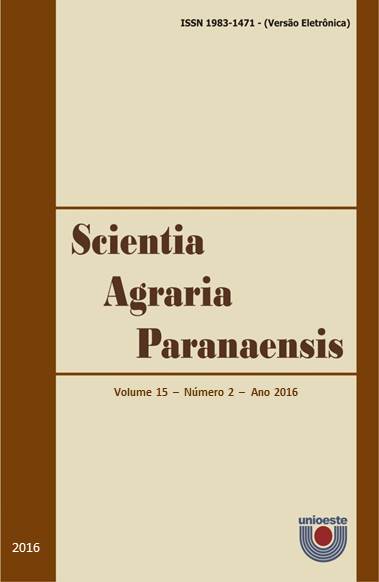Conservação de morango tratado com choque térmico
DOI:
https://doi.org/10.18188/sap.v15i2.11727Palavras-chave:
antocianinas, fenólicos totais, Fragaria x ananassa Duch, patógenos, pós-colheitaResumo
Choque térmico tem sido estudado como método auxiliar de conservação de morangos. A eficiência no controle microbiológico e aumento da vida útil deste método por imersão dos frutos em água aquecida foi comprovada, e choque térmico com ar aquecido pode ser uma alternativa viável na conservação de morangos. O presente trabalho teve por objetivo avaliar o efeito do choque térmico com ar aquecido na composição química e na conservação de morangos ‘Dover’. Os frutos foram tratados termicamente em estufa de ar aquecido a 45 °C por 3 h e depois armazenados a 5 ºC. As análises foram realizadas após intervalos de 1, 7 e 14 dias de armazenamento refrigerado, e após estes períodos, os morangos também foram analisados após 2 dias a 20 ºC. Compostos fenólicos totais, antocianinas, ácido ascórbico, acidez titulável, sólidos solúveis, perda de massa e incidência de fungos foram avaliados. De acordo com os resultados, o tratamento térmico favoreceu o conteúdo de fenólicos totais dos morangos, mas não o conteúdo de antocianinas. O tratamento térmico inibiu o desenvolvimento de patógenos nos morangos durante o armazenamento, mas não apresentou influência sobre a perda de massa fresca. Esse estudo mostrou que não houve aumento da vida útil dos morangos, ficando limitado aos sete dias de armazenamento refrigerado.
Downloads
Publicado
Como Citar
Edição
Seção
Licença
Aviso de Direito Autoral Creative Commons
Política para Periódicos de Acesso Livre
Autores que publicam nesta revista concordam com os seguintes termos:
1. Autores mantém os direitos autorais e concedem à revista o direito de primeira publicação, com o trabalho simultaneamente licenciado sob a Licença Creative Commons Attribution que permite o compartilhamento do trabalho com reconhecimento da autoria e publicação inicial nesta revista.2. Autores têm autorização para assumir contratos adicionais separadamente, para distribuição não-exclusiva da versão do trabalho publicada nesta revista (ex.: publicar em repositório institucional ou como capítulo de livro), com reconhecimento de autoria e publicação inicial nesta revista.
3. Autores têm permissão e são estimulados a publicar e distribuir seu trabalho online (ex.: em repositórios institucionais ou na sua página pessoal) a qualquer ponto antes ou durante o processo editorial, já que isso pode gerar alterações produtivas, bem como aumentar o impacto e a citação do trabalho publicado (Veja O Efeito do Acesso Livre).
Licença Creative Commons
Esta obra está licenciada com uma Licença Creative Commons Atribuição-NãoComercial-CompartilhaIgual 4.0 Internacional, o que permite compartilhar, copiar, distribuir, exibir, reproduzir, a totalidade ou partes desde que não tenha objetivo comercial e sejam citados os autores e a fonte.


